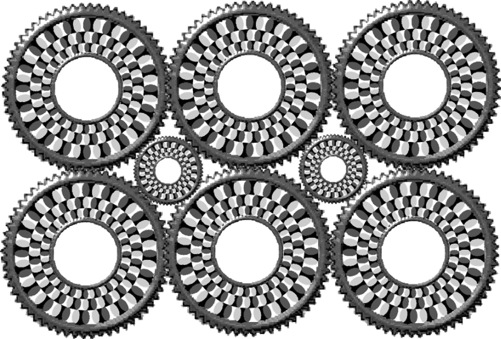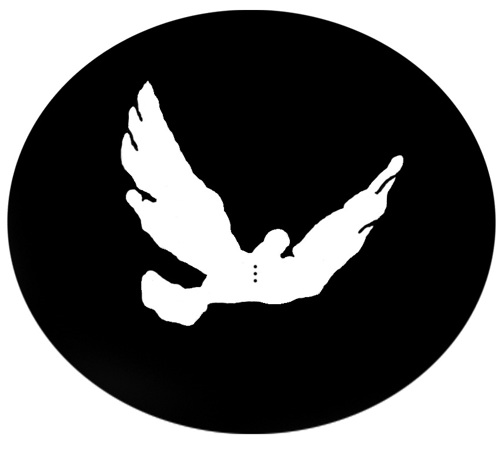Choices and Illusions (9 page)
Read Choices and Illusions Online
Authors: Eldon Taylor

through this same word lens should be even more conspicuously
ridiculous. Still, for most, it is precisely through the lens of words that both self and the world are known.
We know much more than we know, at least about ourselves.
We all came into this world knowing how to naturally sense our
environment, how to explore and provide honest feedback about
our feelings, how to allow our imaginations to deliver intuitions
and images without challenge, and then to feel them for that value
alone. But alas, we all learned to be educated and to cherish thinking, not just free thinking, but thinking according to the taught
order of correct thinking (e.g., mathematics, logic, and so on). Once the rules of thinking were learned, we were graded on our ability to reproduce the method in our every walk and talk of life, including
how we talk to ourselves.
There is a great book titled
A Little Book on the Human Shadow
by Robert Bly that adds yet another relevant dimension here. The
idea is simple: not only do we come into the world equipped with
honesty and innocence, but we openly express these qualities until
we are taught otherwise. At some point others have told us negative things about ourselves—aspects of ourselves that we then begin
to hide. Sometimes we tuck these parts away so well that we hide
them from ourselves. So when little Johnny is told that it’s not okay to get angry, for instance, he hides the anger. When Johnny is told that he shouldn’t cry, he hides tear-inducing emotions, and so on.
33
Choices and Illusions Interior.indd 33
6/20/13 3:41 PM
CHOICES AND ILLUSIONS
In Bly’s words, he puts it in a “long bag” that he will drag with
him all his life.2 One day the long bag is so full of what we have
hidden that we become immobilized by its weight. Growth stops,
and we stagnate. Sometimes we are too afraid to look into the long
bag, to say nothing of beginning to unload it in healing ways. That does not stop the contents from unloading on us, however. One
day Johnny finds himself all tight inside, and suddenly his anger
explodes on his wife or children—he is over the top and perhaps
without a reason at all.
Subverting Our Natural Selves
As we incorporate our learned methods of thinking with our
acquired meanings or values for events and words, we subvert our
natural selves to the higher order of being what we should be—
unnatural. Our extended dependent maturation made us particu-
larly vulnerable to such basic needs as protection and nourishment
and, therefore, additionally vulnerable to supplanting ourselves
with the personification of what was expected, what was accepted,
what was tolerated, what brought reward, and what avoided pun-
ishment. To that extent, even in rebellion, we formed a bond
with a self that was perhaps alien to our true selves. Moreover, we anchored all of this emotional memory in and with words, and
then we explained ourselves and our emotional outbursts using
a socially acceptable vocabulary such as, “It’s okay to get even.”
This only further masked our real feelings (insecurities such as
anger, fear, and isolation) while encouraging additional distortions.
Of course, there was always the alternative—outright rejection—
although this, too, is a distorted perspective. For many people,
this distortion translates into a poor self-image: “I’m no good.”
My research with incarcerated criminals suggests that there is yet
another step, or level, to this kind of distortion—the step from high self-alienation to and including high social alienation. When this
occurs, the self-image is verbalized more like this: “I’m no good,
and neither are you. You [people like you] did it to me. You [some-
one] made me this way.”
34
Choices and Illusions Interior.indd 34
6/20/13 3:41 PM
What We perceive and Fail to perceive
As semantic descriptions are built, semantic reactions or
responses are encoded and a semantic belief system is coherently
hinged to the degree that coherence is possible within the rules of thinking as we have learned them. When incoherence is obvious, a
defense mechanism is employed to mask the failure, and semantic
distortions are created.
To a cognitive psychologist, this kind of thinking is known as
cognitive dissonance, or holding two opposing views, opinions,
or beliefs without recognizing that they are mutually exclusive.
(Remember the example I used earlier, in which individuals desired
to tax the rich until it was their money being taxed.) The outside
world, together with the inside world, has at this point become
more or less a series of semantic anchors composed of semantic
descriptions, semantic reactions, and semantic beliefs and distor-
tions all stitched together like a fisherman’s net with semantic
references definitionally reinforcing each other.
False to Fact
To use the words of scientist Alfred Korzybski, who devel-
oped semantic theory, our world has now become, perhaps more
often than any sane person would like to admit, false to fact and
therefore necessarily distorted. As Korzybski puts it, the difference between sanity and insanity can be found in false-to-fact distortions that are semantic in nature.3 It is precisely the mechanism of semantic distortions that underlies thinking processes that are or
become neurotic or psychotic, and that gives rise to self-sabotaging behavior and self-limiting beliefs. This very same mechanism—and
mechanism
is a good word because the process becomes so automatic that it operates without our conscious awareness— martials
our defenses to action whenever our semantic descriptions, seman-
tic reactions, and semantic beliefs and distortions (semantic pro-
cesses) are challenged. In fact, the unconscious pervasiveness of
the mechanistic nature of these semantic processes is such that
even the most knowledgeable of specialists on the matter must
maintain a constant vigil to guard against them. This may explain
35
Choices and Illusions Interior.indd 35
6/20/13 3:41 PM
CHOICES AND ILLUSIONS
why an individual can succeed brilliantly in a given field and fail miserably in another.
Our language usage, the value and meaning we attach to words,
can blind our rational thinking. We could effectively argue that
genius escapes this language barrier, for genius goes beyond the
boundaries, sees the common differently, and gains a perspective
not formerly found. Our world not only assigns values to words
but also insists on a sort of “is-ness” property that somehow gives the word an existence of its own. The label, the noun, becomes the
thing. The verb may even vicariously become the action.
We all can be fooled by word propositions that address defi-
nitional meanings, is-ness, and rules, the so-called logic of our
methods and use (or misuse) of language and thinking. A theist
could argue that God is all-powerful, while the atheist might refute this claim with such a question as, “Can God create a stone so
large he can’t lift it?” Word traps and their confusion have led to many atrocities.
It’s easy to forget the nature of personal truth when it masquer-
ades in an argument of reason. logic and linguistics make asser-
tions about many things that are simply false to fact. For example, logic asserts that a gallon is equal to a gallon. This is simply not true from many perspectives, including the most obvious. A gallon
of water added to a gallon of alcohol does not equal two gallons of combined fluid. Ergo, 1 + 1 = 2 is not necessarily so in the “real”
world, for no two things are alike in every way. Additionally, it is not possible to know the so-called total of anything. Words are not the things they represent, and what they are supposed to represent
is much more, and much less, than could ever be written. Indeed,
as has been said many times, probably in its most noteworthy form
by the philosopher ludwig Wittgenstein, “Whatever we say about
something, it is also not that.” Words are not things, and word
things, such as a griffin, do not necessarily exist.
36
Choices and Illusions Interior.indd 36
6/20/13 3:41 PM
What We perceive and Fail to perceive
Illusions
So if our words trick us, then that “stream of consciousness,” in
the words of American philosopher William James, also tricks us.
All those inner conversations with ourselves, all the self-talk, trick us just as assuredly. Still, that is not the only illusion our minds are capable of.
If our words trick us, then that “stream of consciousness,”
in the words of William James, also tricks us.
When in doubt, most people will trust their own judgment
and senses—in fact, it is very hard not to trust our own experi-
ences. Yet our biology and psychology function in such a way that
we have to question even our own experiences and feelings if we
are to have any chance of discovering “the truth.” The following
illusions are very interesting, and you may be familiar with many
of them. The important thing here for you to realize is that if your senses can trick you in this way, what can you really trust? Once
you have understood how easily you can be tricked into thinking
something that you can see with your own eyes is just not true,
then it becomes more conceivable that many other things that you
hold to be true may in fact not be so—and your journey to finding
yourself can actually begin. A word of caution, though, as William
James once said: “A great many people think they are thinking
when they are merely rearranging their prejudices.”
37
Choices and Illusions Interior.indd 37
6/20/13 3:41 PM

CHOICES AND ILLUSIONS
So, let’s start with some visual illusions. We often see what is
not there and often fail to see what is. Further, we are very suggestible and can easily see what is suggested. let’s take some common
images for purposes of illustration and turn this idea into experi-
ence. The following is commonly circulated on the Internet:
Figure 3
Art by Antonio Zamora, derived from a design by A. Kitaoka
Reprinted with permission.
(For links to this and many other illusions that work better in color on a computer screen, go to
www.eldontaylor.com/choicesandillusions
.)
Stare a moment at the image in Figure 3, and you will find that
the gears seem to move. Change your gaze from center to corners,
and different gears seem to move or move more rapidly. Of course,
in reality nothing moves at all.
The next picture should be looked at in a special way. It appears
on a page by itself for this reason. When you turn the page, look
only at the page. Stare at the center three dots. Concentrate on
38
Choices and Illusions Interior.indd 38
6/20/13 3:41 PM
What We perceive and Fail to perceive
those dots for one minute. Stare only at the dots, and after that
minute, turn and look at a blank wall. Gaze at the wall for approximately 45 seconds. Allow yourself to relax your focus, but keep your gaze on the same space on the wall, even if you think that nothing
is going to happen. Something unique will happen, and you should
know that this can be done with any number of pictures. What
you will see will amaze you, even startle you.
Turn the page, and follow these instructions. Enjoy!
39
Choices and Illusions Interior.indd 39
6/20/13 3:41 PM
